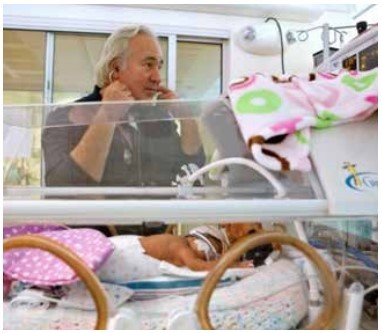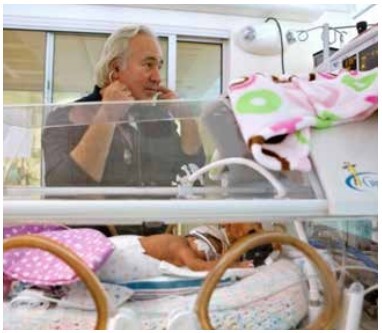Commercializing Newest Nerve Regeneration Protocol and New Discoveries in the Field of Photonics
- 16 Jun 2016
- Volume 7
- NanoScientific Magazine, Summer 2016
A Profile of Dr. Jayakumar Rajadas, PhD, Biomaterials and Advanced Drug Delivery Research

Phd, Biomaterials And Advanced Drug Delivery Research
"AFM IS AN IMPORTANT TOOL FOR US TO USE IN NANO PATTERNING. WE USE PARK NX10 ATOMIC FORCE MICROSCOPE TO HELP US UNDERSTAND MOLECULE INTERACTIONS AND IDENTIFY THE NANO STRUCTURES OF PROTEINS.”
Dr. Rajadas is the founding director of the Biomaterials and Advanced Drug Delivery Laboratory at Stanford University. This center has been involved in transforming biophysical ideas into biomaterial and drug delivery technologies. These technologies include microencapsulation of drugs, vascular grafts, bio-implants, development of small molecule and protein-based drugs, regeneration of nerve and cardiovascular tissues, and wound healing applications. He is also a Lecturer in the Department of Neurology and Neurological Sciences. His research has involved transforming nano science ideas into biomaterial and drug delivery technologies. Before moving to Stanford, he served as the founding chair of the Bio-organic and Neurochemistry Division at one of India’s national laboratories. He is a recipient of several awards including Young scientist award in chemistry for the year 1996 from the Government of India. He has also won the best scientist award from the Tamilnadu State Government India in the year 1999. He is also co-recipient of nine SPARK translational awards in Stanford University. He has published over 150 papers with numerous patent disclosures. He received his MS in Chemistry at the University of Madras and his Ph. D in Biophysical Chemistry at the Indian Institute of Technology.
Before moving to Stanford, he served as the founding chair of the Bio-organic and Neurochemistry Division at one of India’s national laboratories, Central Leather Research Institute Chennai, India, where he was responsible for both the organization and management of the division. His backgrounds in biochemical pharmacology and physical-chemistry have allowed him to effectively translate physical concepts into novel formulation technology. “Pre-Designed nanosomes interact with biofluids such as blood and biological secretions to develop into structures of desired patterns. We have shown these soft particles can recognize endothelial linings of the blood capillaries that are proximal to the affected tissues in the heart, brain and liver. We have used these structures to stabilize and target the fragile peptides, proteins and water insoluble therapeutic molecules to different organs.” “My research foresees the application of various technologies in a research domain for developing novel formulation and therapeutics that would direct towards invention and targeted drug delivery systems. I have used biophysical and pharmacology approaches for the identification of the most optimal micro environments to implant the stem cells to repair injured skin, heart and brain. My expertise in stem cell survival and differentiation is currently utilized in developing technology for high yield survival of purified cardiovascular cells in the transplantation and imaging studies. I have also developed novel drug targeting approach using protein corona formation on the soft nano particles delivered in the blood and body fluids. My research is also involved in further the knowledge of genomic and proteomic changes due to the proteotoxic stress in immune cells, cardiomyocytes and neurons.” Dr. Jayakumar’s extensive work with micro needles has contributed to a new drug delivery method, using micrometer-scale needles that dissolve in the skin that can eliminate the pain and dangers of hypodermic needle use and enhance delivery of the drug across the skin. Transdermal micro needles create micron sized pores in the skin, ideal for patients who can administer the drug by themselves . This method of drug delivery does not reach nerve fibers and blood vessels in the dermis and the drug gets directly into systemic circulation and is ideal for drugs with poor absorption rate.

Nerve conduits using techniques inspired by nanotechnology
Nerve Regeneration Protocol Under License Nerve tissue engineering is a rapidly evolving and expanding field in the realm of biomedicine where newest methods can create, repair, replace cells, tissues and organs by using cell or combinations of cells with biomaterials and biologically active molecules which helps to produce materials which very much resembles to body's native tissue/tissues. New materials used for manufacturing nerve conduits offer such exciting results that the nerve regeneration company AVIVE is already onboard to license the new technology coming from Stanford School of Medicine. Dr. Rajadas and the BioADD have recently licensed their formulation to deliver Bestatin for pulmonary hypertension to Eiger, a clinical –stage biopharmaceutical company. Developed in collaboration with Dr. Mark Nicolls, Professor of Medicine Pulmonary and Critical Care at Stanford, a lab that focuses primarily on the contribution of the immune response to lung disease, this product is in phase II clinical trials. At Dr. Nicolls lab, they are specifically examining the contribution of inflammation to the development of pulmonary hypertension. LaJolla Pharmaceutical has licensed a liver targeting nano formulation for the treatment of pediatric jaundice and adult liver fibrosis, developed in collaboration with Dr. David Stevenson, who was recently honored with the 2016 Joseph W. St. Geme Jr. Leadership Award by The Federation of Pediatric Organizations for his dedicated career to improving the lives of the smallest and sickest babies. Part of Dr. Stevenson’s research is focused on the study of the ontogeny and control of heme catabolism and bilirubin production in the developing neonate. Neonatal jaundice occurs when bilirubin, which is produced when the body disposes of excess red blood cells, builds up too quickly for disposal by the infant's immature liver and affects more than half the newborn babies in this country, according to the American Academy of Pediatrics. In most instances the condition resolves itself without treatment. But in rare cases the bilirubin levels are high enough to enter the brain and interfere with nerve cell signaling. If left untreated, the infant may die from prolonged exposure to the elevated levels.

David K. Stevenson, MD, renowned neonatology leader at Lucile Packard Children's Hospital Stanford and Stanford Children's Health, is seen at work in our neonatal intensive care unit. He has been named recipient of the 2016 Joseph W. St. Geme Jr. Leadership Award by The Federation of Pediatric Organizations. Stevenson will be presented the award on April 30 at the Pediatric Academic Societies Meeting in Baltimore. (Photo: Business Wire) Stanford neonatology pioneer Dr. David Stevenson has been named recipient of the 2016 Joseph W. St. Geme Jr. Leadership Award by The Federation of Pediatric Organizations.
At the Biomaterials and Advanced Drug Delivery laboratory at Stanford, they have developed a Nano-carrier combination platform, consisting of lipids and serum proteins, to develop novel structures that can recognize impaired heart and liver tissues. For the first time, they have used this technology to stabilize fragile peptides, proteins and water insoluble therapeutic molecules to target the delivery of these molecules to different organs. Jayakumar Rajadas and his researchers have also discovered drugs with the potential to eliminate the Lyme disease-causing bacteria Borrelia burgdorferi at the onset of infection. He has developed novel therapeutic molecules for the treatment of Lyme disease and identified a upregulated stress protein as a bio marker in the Post treatment Lyme syndrome. He uses various biophysical approaches such as AFM, fluorescence, and NMR to understand the structural details of neurotoxic oligomeric forms of misfolded proteins involved in neurodegenerative diseases. For the past eight years, his lab has also been involved in transforming biophysical ideas into biomaterial and drug delivery technologies. These technologies include microencapsulation of drugs, vascular grafts, bio-implants, development of small molecule and protein-based drugs, regeneration of nerve and cardiovascular tissues, and wound healing applications. He has published over 155 papers in peer-reviewed journal articles including publications in Nature Medicine, Science Translational Medicine, Molecular Cell, Journal of Clinical Investigation, and the Proceedings of the National Academy of Sciences (USA). Dr. Rajadas has numerous patent disclosures and seven products he has developed were licensed to commercial firms.
